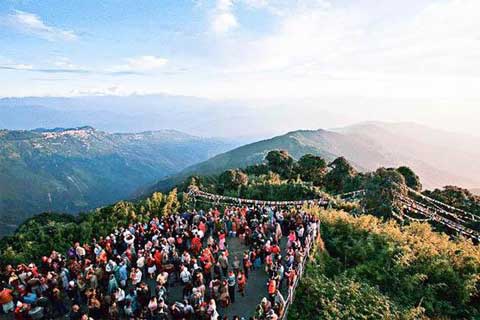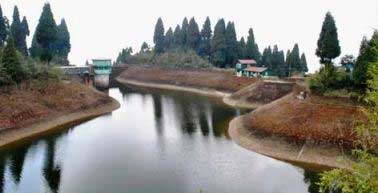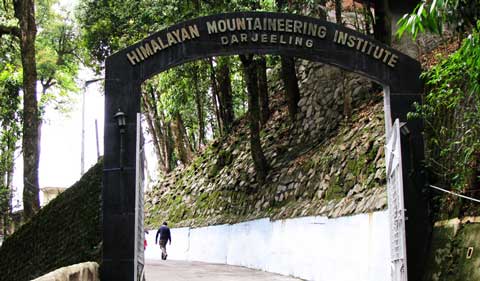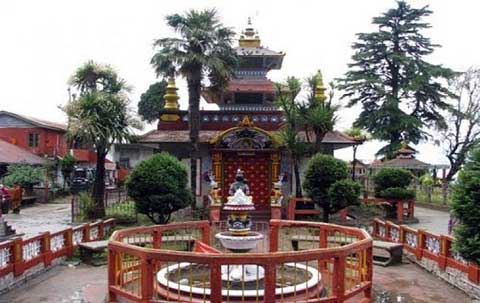DARJEELING
The 'Queen of Hills', Darjeeling is arguably the most popular tourist destination in northeast India. Situated at an altitude of 2134m, this hill town, with its exquisite scenic beauty, attracts travelers of varied interest.
It is the Abode of Lord Shiva and offers spectacular views of Kanchenjunga and the hospitality of colorful Himalayan people. Darjeeling and all her tea plantations lie under the shadow of this snowy Himalayan giant. The town is just 78 km from Siliguri (the major rail and road head) and is well connected by Bus and jeep.
If you are planning a tour to Darjeeling, we recommend spending two to three nights in the town to capture all its beauty. Many tourists like to combine Sikkim with a tour to Darjeeling town. The most common tourist destinations around are Kalimpong, Mirik, Kurseong in the Darjeeling hills and Gangtok, Pelling or North Sikkim area.

History Of Darjeeling
Until the beginning of the 18th century, the area between the present borders of Sikkim and the plains of Bengal, including Darjeeling and Kalimpong, belonged to the kings of Sikkim. In 1706 the king lost Kalimpong to the Bhutanese.
And control of the remainder was wrested from them by the Gurkhas who invaded Sikkim in 1780, following the consolidation of the latter's rule in Nepal.
One such dispute in 1828 led to the dispatch of two British officers to this area, and it was during their fact-finding tour that they spent some time at Darjeeling. The officers were quick to appreciate Darjeeling's value as a site for a sanatorium and hill station and as the key to a pass into Nepal and Tibet. The officers' observations were reported to the authorities in Calcutta and a pretext was eventually found to pressure the king into granting the site to the British.
These annexations brought about a significant change in Darjeeling's status. Previously it had been an enclave within Sikkimese territory, and to reach it the British had to pass through a country ruled by an independent king. After the takeover, Darjeeling became contiguous with British territory further south and Sikkim was cut off from access to the plains except through British territory. This eventually led to the invasion of Sikkim by the Tibetans and the British military expedition to Lhasa.
The tensions finally came to a head in widespread riots throughout the hill country which continued for several years, and in which hundreds of people lost their lives and thousands were made homeless. Tourism came to a grinding halt. The movement was lead by the Gorkha National Liberation Front (GNLF), led by Subash Ghising, which demanded a separate state to be known as Gorkhaland.
Major Sightseeing Locations
 Tiger hill
Tiger hill
Standing at a height of 2590m, Tiger Hill is 11 km from the main town. The place is famous for its magnificent view of Kanchenjunga, Mt. Everest and other eastern Himalayan peaks especially at the time of sunrise.
 Zoological Park
Zoological Park
About 2 km. from the town, this zoo houses a wide collection of high-altitude birds and animals, India's only collection of Siberian tigers and some rare species such as the red panda. The Padmaja Naidu Himalayan Zoological Park is famous for its success in the snow leopard breeding program.
 Lloyd Botanical Garden
Lloyd Botanical Garden
The garden, located below the bus stand, is worth a dekko for its representative collection of Himalayan plants, flowers, and orchids. The serenity of the sylvan atmosphere that the garden offers is another reason for its attraction.
 Passenger Ropeway
Passenger Ropeway
At North Point, it is ready to offer you a joy ride. About 4 km from Darjeeling town. There was an accident in this ropeway and because of this, the ropeway remained closed for several years.
 Ghoom Monastery
Ghoom Monastery
The most famous monastery around, also known as Yogachoeling Gompa, enshrines an image of Maitreya Buddha (the coming Buddha), it is about 10 km from town.
 Senchal Lake
Senchal Lake
The source of domestic water of the town, located near the Tiger Hill.
 Himalayan Mountaineering Institute (HMI) & Museum
Himalayan Mountaineering Institute (HMI) & Museum
Adjacent to the Zoological Park, HMI runs courses on mountaineering. It has a mountaineering museum containing mountaineering gears and the specimens of Himalayan flora & fauna. The Everest Museum at HMI exhibits the history of attempts on the great peak. The museum also exhibits equipment used by Tenzing Norgay (who lived most of his life here) and Edmund Hillary on their way to Mt. Everest and a letter written by George Mallory, the British climber who was lost while climbing Mt. Everest and whose body was found just a few years back.
 Dhirdham Temple / Mahakal
Dhirdham Temple / Mahakal
A Hindu temple, it is modeled on the famous Pashupati Temple of Kathmandu.